Presidential Burial Sites- Discover the Burial Places of U.S. Presidents
Purchases made through links earn us a small commission, at no extra cost to you.
The resting places of U.S. Presidents are more than mere burial sites; they are historical markers, encapsulating the essence of individuals who shaped America.
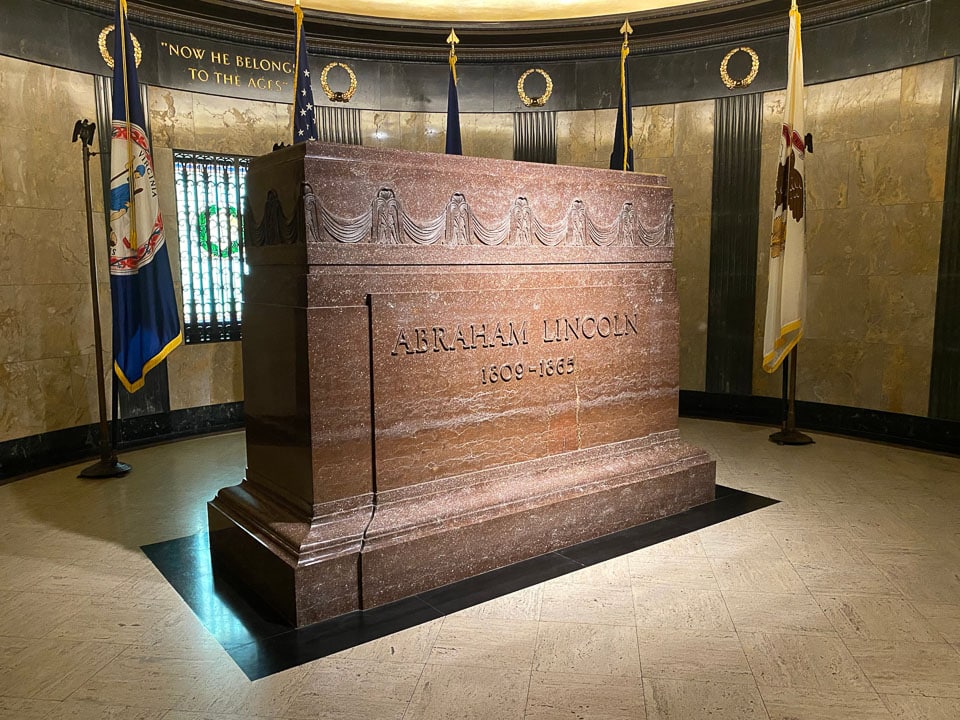
In This Post
Presidential Burial Sites- The Location of Each U.S. President’s Grave or Tomb
Whether it be under a modest headstone or prominent monument, or inside a decorated sarcophagus or grand mausoleum, the presidents’ burial sites memorialize each individual, their achievements, and contributions to the country.
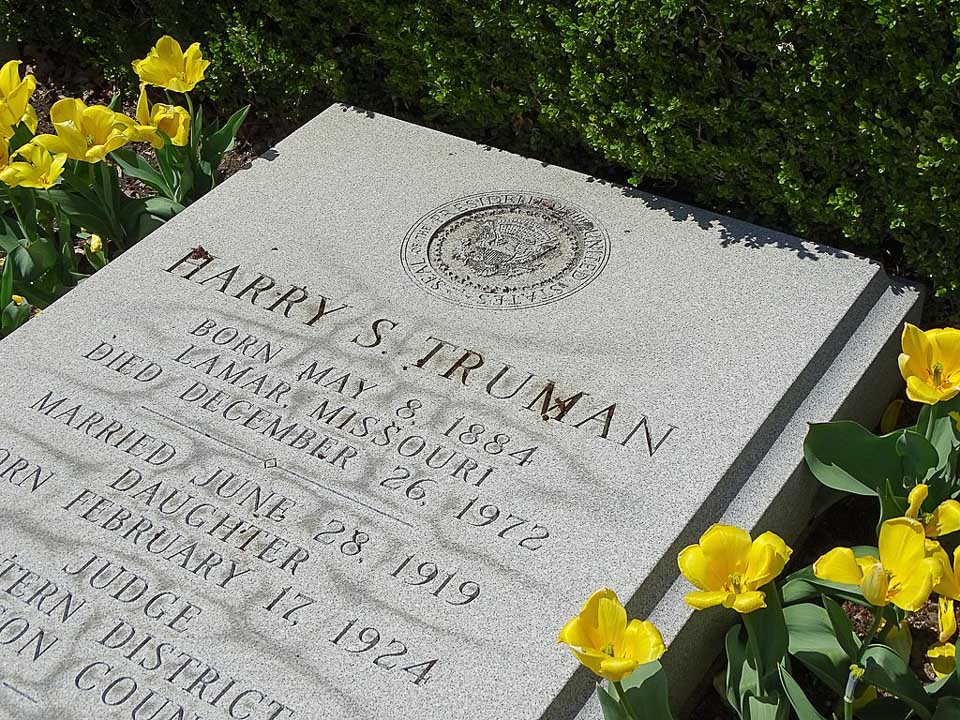
The tombs and graves of U.S. presidents can be found at family estates, prestigious military cemeteries, community cemeteries, churches and cathedrals, presidential libraries and museums, and stately mausoleums. Each burial site is a reminder of the leadership and sacrifice that helped build the United States.
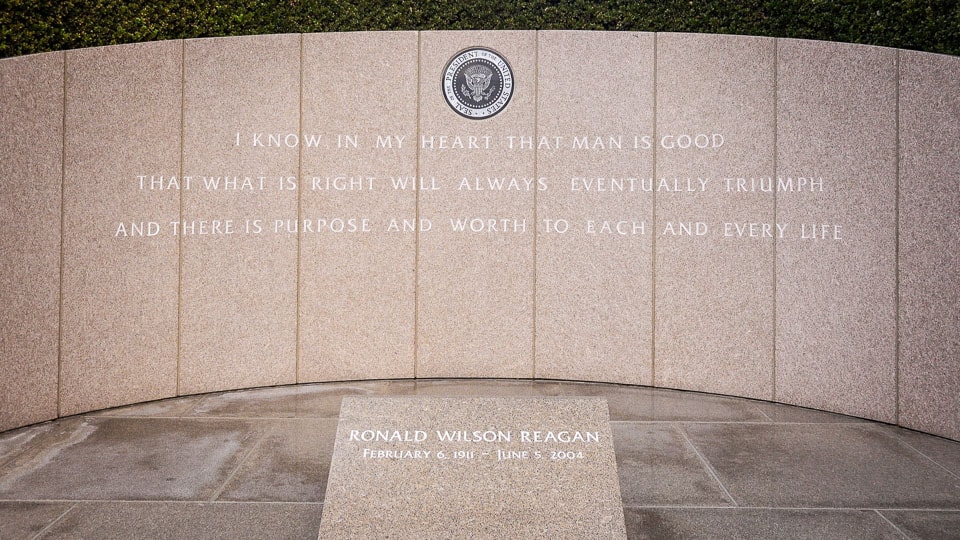
Here is a list of the burial places of U.S. presidents, along with a summary of their time in office and a description of where they are interred.
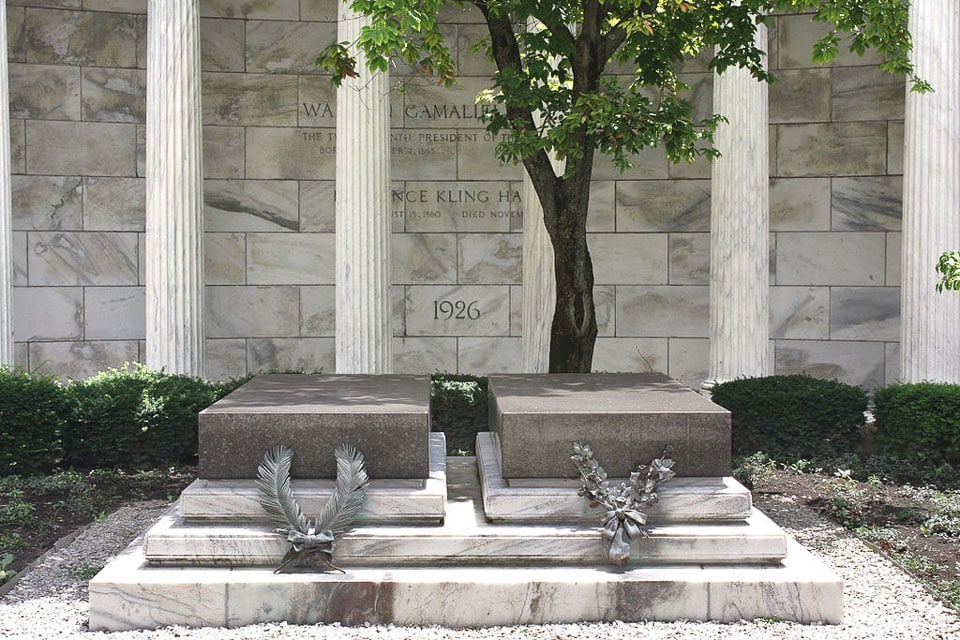
George Washington
Burial Place: Washington’s Mount Vernon Estate, Virginia
George Washington was the first president of the United States, serving from 1789-1797.
Known as the “Father of the Nation”, Washington had a vital role in securing American independence from Great Britain. As Commander in Chief of the Continental Army during the American Revolutionary War, he led Patriot forces to victory despite facing numerous challenges. Washington later presided over the Constitutional Convention in 1787 and played a vital role in drafting the United States Constitution. His commitment to the principles of the Republic earned him the unanimous support of the Electoral College, making him the first President of the United States in 1789.
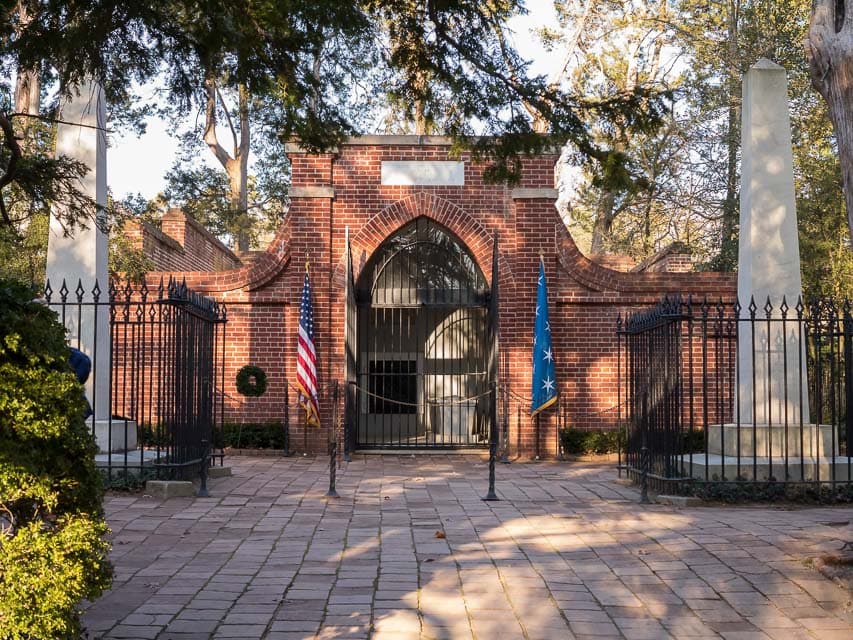
After he died in 1799 at the age of 67, Washington’s body was interred in the old family vault at his Mount Vernon estate until construction on a new vault was complete. The new brick tomb of George Washington created a larger and more secure space for his marble sarcophagus and that of his wife, Martha. Several other family members are also entombed in the family vault including nieces, nephews, and his half-brother.
John Adams
Burial Place: United First Parish Church in Quincy, Massachusetts
John Adams became the first vice president under George Washington and in 1797 he succeeded Washington as the second President of the United States.
Also a Founding Father of the United States, Adams participated in the American Revolution and the drafting of the Declaration of Independence. Adams faced numerous challenges during his presidency, including the Quasi-War with France and the controversial passage of the Alien and Sedition Acts. He lost his bid for re-election in 1800 to Thomas Jefferson, marking the first peaceful transition of power between political parties in the United States.
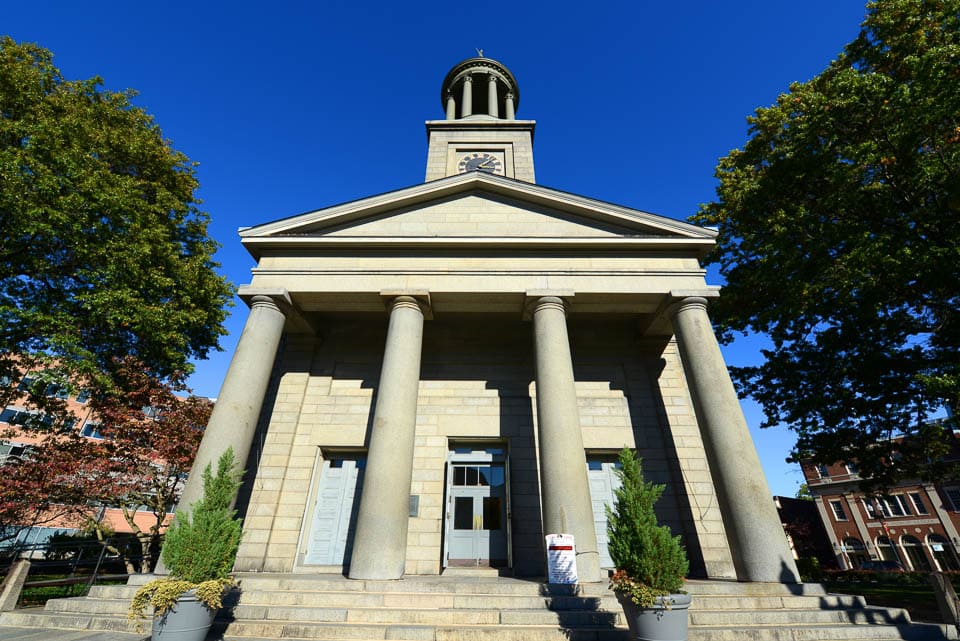
Adams died of a heart attack on July 4, 1826, on the 50th anniversary of the Declaration of Independence. His body was interred alongside his wife’s in the family crypt at the United First Parish Church in Quincy. His simple tomb is engraved with his name and a plaque is affixed to the wall outside his crypt paying tribute to Adams as “signer of the Declaration of Independence, framer of the constitution of Massachusetts, [and] second president of the United States.”
Thomas Jefferson
Burial Place: Jefferson’s Monticello Estate, Virginia
Thomas Jefferson served as third president of the United States from 1801-1809 after stints as secretary of state and vice president.
Jefferson was a key figure in American history and one of the Founding Fathers of the United States. He was the primary author of the Declaration of Independence and made significant contributions to the fields of architecture, science, and education. His presidency was marked by the Louisiana Purchase in 1803, which doubled the size of the United States, and his legacy is that of a champion of democracy and enlightenment ideals.
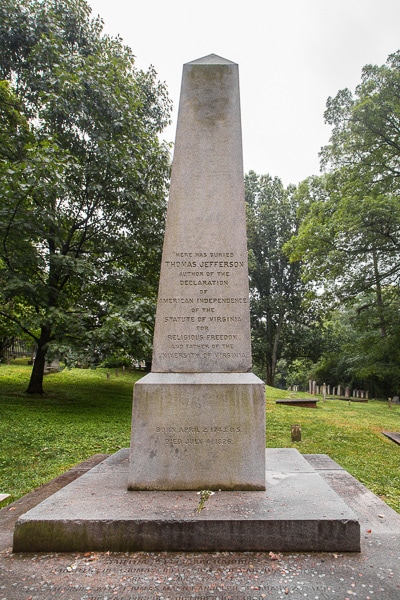
Jefferson died at age 83 on July 4, 1826 (hours before John Adams), on the 50th anniversary of the adoption of the Declaration of Independence. His body was buried in the cemetery at Jefferson’s Monticello Estate near Charlottesville, Virginia. Jefferson’s gravesite is marked by an obelisk erected by the United States in 1883, replacing the smaller original one designed by Jefferson. It’s engraved with “Here was buried Thomas Jefferson, Author of the Declaration of American Independence, of the Statute of Virginia for religious freedom, and Father of the University of Virginia.”
James Madison
Burial Place: Madison’s Montpelier Estate in Orange County, Virginia
From 1809-1817, James Madison was the fourth president of the United States and is often hailed as the “Father of the Constitution” for his critical work in drafting and promoting the United States Constitution as well as the Bill of Rights.
During Madison’s presidency, the United States faced challenges such as the War of 1812 against Britain, during which the capital, Washington, D.C., was briefly occupied by British forces. After his presidency, Madison retired to his plantation, Montpelier, in Virginia where he continued to be involved in public affairs, including serving as Rector of the University of Virginia.
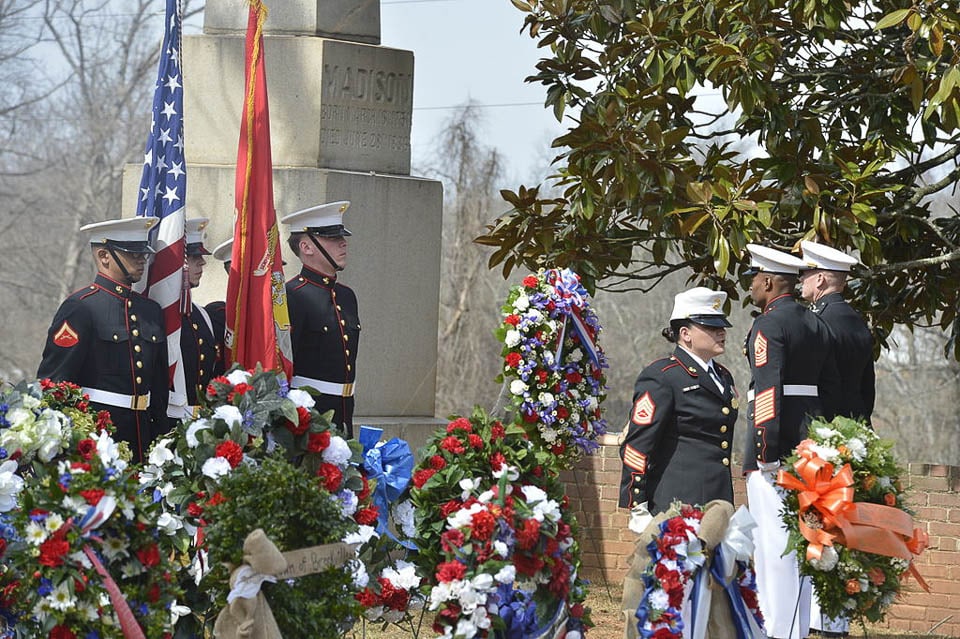
Madison passed away from heart failure on June 28, 1836, at the age of 85, and was buried in the family cemetery at Montpelier. The cemetery is surrounded by a low brick wall and Madison’s grave is marked with a large obelisk engraved with his dates of birth and death.
James Monroe
Burial Place: Hollywood Cemetery in Richmond, Virginia
James Monroe was the fifth President of the United States, serving two terms from 1817 to 1825.
Monroe’s presidency is often referred to as the “Era of Good Feelings” due to a relative absence of partisan strife during his time in office. Notable accomplishments of his administration include the acquisition of Florida from Spain and the formulation of the Monroe Doctrine in 1823 which opposed European colonialism in the Americas and asserted the United States’ position as the dominant power in the Western Hemisphere.
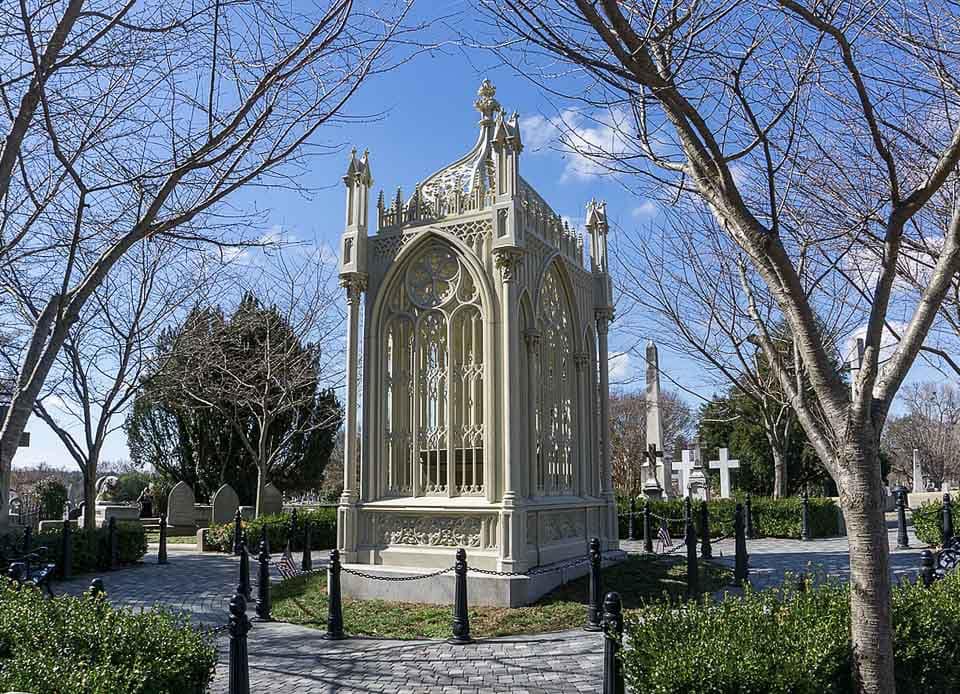
Monroe was the third president to die on Independence Day, passing away on July 4, 1831. He was originally buried at the New York City Marble Cemetery in the Gouverneur family’s vault, but was re-interred 27 years later at the Hollywood Cemetery in Richmond, Virginia. His granite sarcophagus rests on a plinth and is surrounded by an elegant Gothic Revival “cage” made out of cast iron. The unique architecture of the James Monroe Tomb led to it being declared a National Historic Landmark in 1971.
John Quincy Adams
Burial Place: United First Parish Church in Quincy, Massachusetts
John Quincy Adams was the sixth President of the United States, serving from 1825 to 1829. He was the son of John Adams, the second President of the United States.
As president, Adams advocated for infrastructure improvements and promoted a national university. However, his presidency faced challenges, including political opposition and accusations of a “corrupt bargain” due to the circumstances of his contentious election. After his presidency, Adams served in the U.S. House of Representatives, becoming the only former president to do so, and represented Massachusetts in the House until he died in 1848.
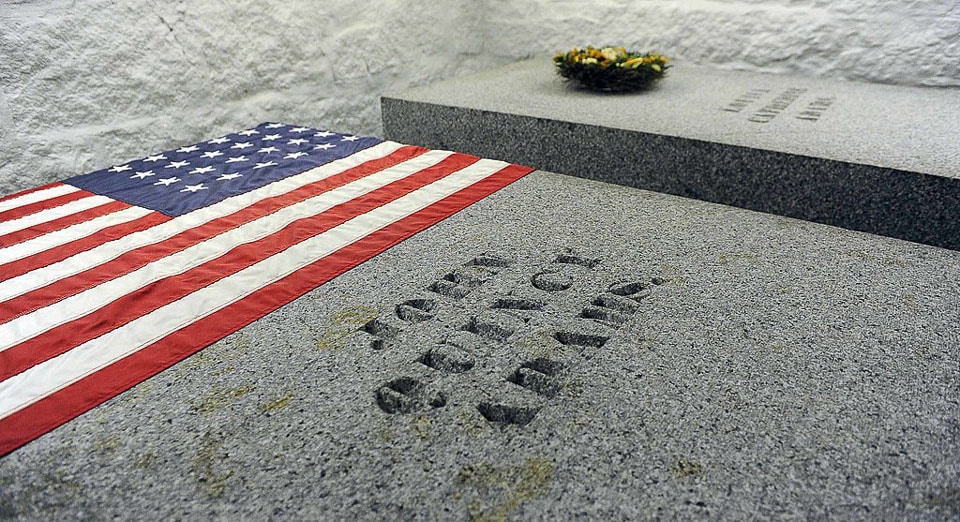
Adams was initially interred at the Congressional Cemetery in Washington, D.C., then moved to Hancock Cemetery in Quincy before being re-interred one more time in the family crypt at the United First Parish Church.
Andrew Jackson
Burial Place: Jackson’s The Hermitage Estate in Nashville, Tennessee
Andrew Jackson served as the seventh President of the United States from 1829 to 1837.
Jackson’s tenure was marked by a commitment to populism and a strong executive branch. His administration faced controversy, including the forced removal of Native American tribes from their ancestral lands.
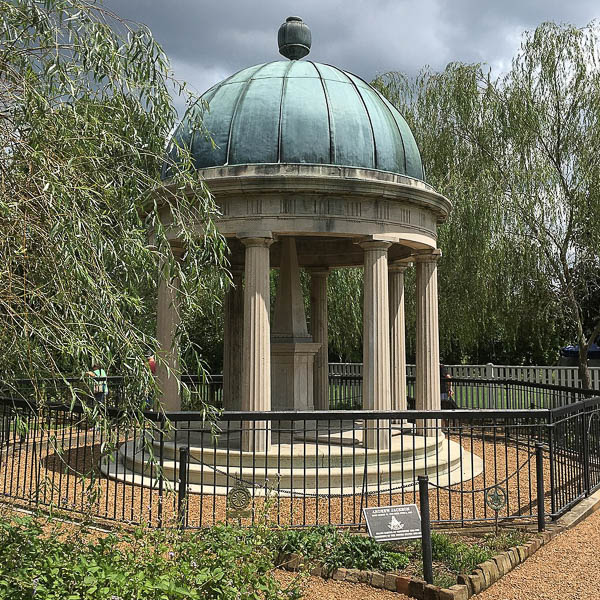
After his presidency, Jackson retired to his estate, The Hermitage, in Tennessee, where he passed away on June 8, 1845. His tomb, in the garden at his estate, is surrounded by columns and covered by a domed roof. The structure resembles a Greek temple and in the centre is an obelisk on a decorative base. The garden also has a small family cemetery beside the tomb.
Martin Van Buren
Burial Place: Kinderhook Reformed Church, New York
Martin Van Buren was the eighth President of the United States, serving from 1837 to 1841.
Van Buren found success as a political organizer, founding and building the Democratic Party. His presidency, however, faced economic challenges, including the aftermath of the Panic of 1837, a severe economic downturn that saw widespread unemployment.
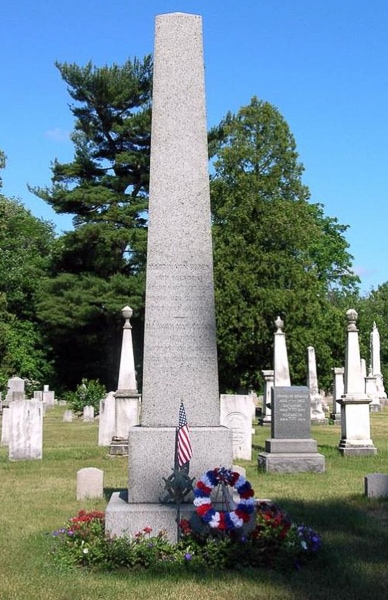
After his death in 1862 at age 79, Van Buren was buried in the cemetery at the Kinderhook Reformed Church. His gravesite is marked by an obelisk and its base is framed by a flower bed.
William Henry Harrison
Burial Place: The William Henry Harrison Tomb State Memorial in North Bend, Ohio
William Henry Harrison was the ninth President of the United States. His presidency was the shortest in American history, as he served only 31 days before succumbing to illness.
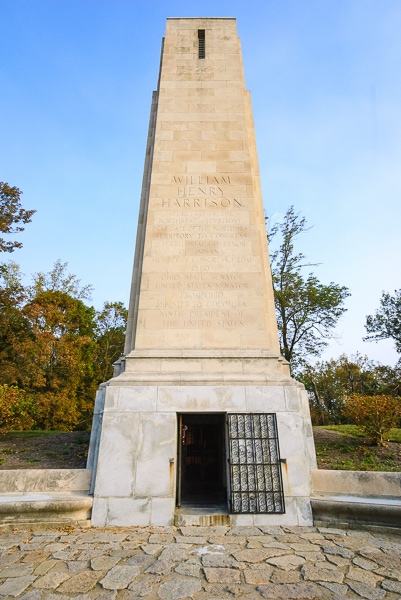
Harrison’s final resting place is a tomb at the summit of Mt. Nebo, on the family estate in North Bend, Ohio. The tomb is a tall rectangular tower with 24 vaults containing the bodies of Harrison and his family members. His burial site is now known as the William Henry Harrison Tomb State Memorial and is listed on the National Register of Historic Places.
John Tyler
Burial Place: Hollywood Cemetery in Richmond, Virginia
John Tyler was the tenth President of the United States, serving from 1841 to 1845. He assumed the presidency after the death of William Henry Harrison, making him the first vice president to succeed to the presidency due to the death of a sitting president.
Tyler’s presidency was marked by tensions with his own party, as he clashed with Whig leaders over economic policies and the re-establishment of a national bank. His use of the presidential veto further alienated him from the Whigs. Notably, Tyler’s administration successfully annexed Texas in 1845, and he supported the admission of Florida as a state.
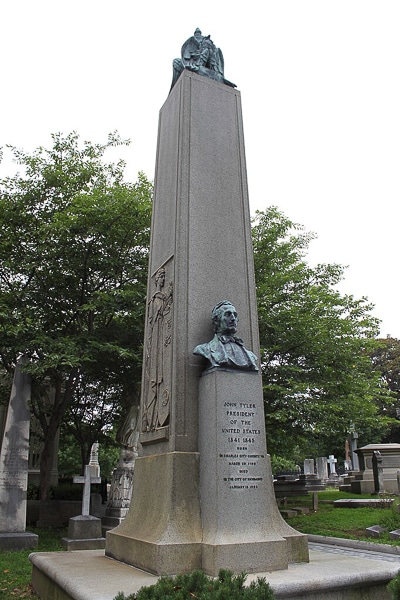
Tyler was buried in Hollywood Cemetery across from the gravesite of President Monroe. His monument features a bust and an engraved pillar topped with an urn.
James K. Polk
Burial Place: Tennessee State Capitol in Nashville
James K. Polk was the 11th President of the United States, serving from 1845 to 1849.
Polk is often praised for accomplishing all four of his major goals during his presidency, which he outlined as acquiring California, settling the Oregon boundary dispute, lowering tariffs, and establishing a sub-treasury system. However, his aggressive expansionist policies also led to controversy and opposition. Having pledged to serve only one term, Polk did not seek re-election.
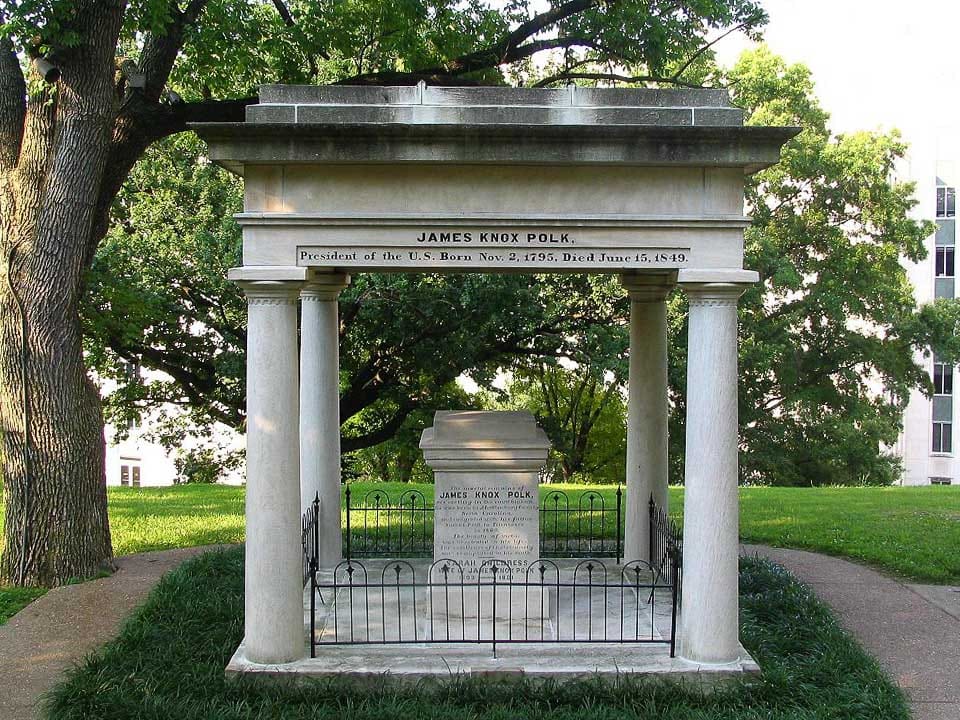
Polk returned to his home in Tennessee and died of cholera on June 15, 1849, just three months after leaving office. After being buried in the Nashville City Cemetery then a tomb at Polk Place, Polk’s remains were moved to the grounds of the Tennessee State Capitol. His gravesite is marked by a pedestal covered with a canopy. The pedestal is engraved with a list of some of his presidential accomplishments.
Zachary Taylor
Burial Place: Zachary Taylor National Cemetery in Louisville, Kentucky
Zachary Taylor was the 12th President of the United States, serving from March 1849 until his death in July 1850.
Taylor was a career military officer, earning fame for his leadership during the Mexican-American War. During Taylor’s 16 months in office, he faced challenges related to sectional tensions over slavery, particularly the debate surrounding the newly acquired territories from the Mexican-American War. Taylor took a moderate approach, advocating for the admission of California as a free state, which drew criticism from Southern pro-slavery advocates.
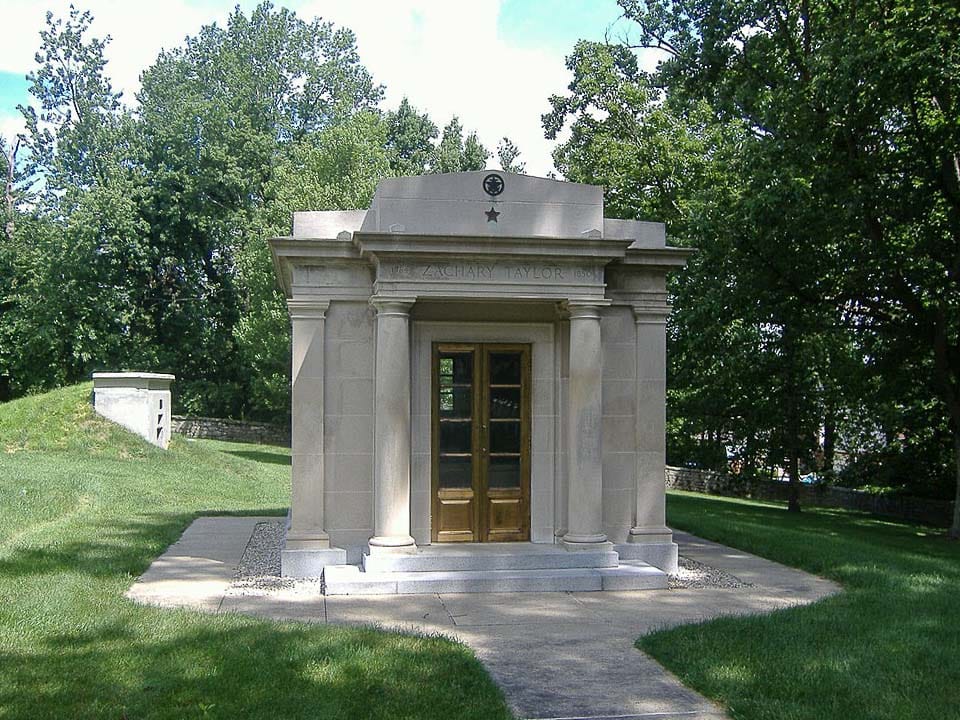
Taylor died on July 9, 1850, likely of acute gastroenteritis but at the time there were suspicions of poisoning. In 1926, Taylor’s body was moved into a small mausoleum at the Zachary Taylor National Cemetery. The mausoleum is made of limestone with a granite base and has a marble interior containing the tombs of Taylor and his wife. Beside the mausoleum is a 50 ft tall monument topped with a statue of Taylor that the Commonwealth of Kentucky erected.
Millard Fillmore
Burial Place: Forest Lawn Cemetery in Buffalo, New York
Millard Fillmore assumed the presidency in 1850 following the death of President Zachary Taylor, making him the 13th President of the United States and the second vice president to take office due to the death of his predecessor.
Fillmore’s presidency was dominated by the ongoing debate over the Compromise of 1850, a series of legislative measures aimed at resolving sectional tensions between free and slave states. The Fugitive Slave Act proved particularly controversial, as it required the return of escaped slaves to their owners and imposed penalties on those who assisted or harboured fugitive slaves.
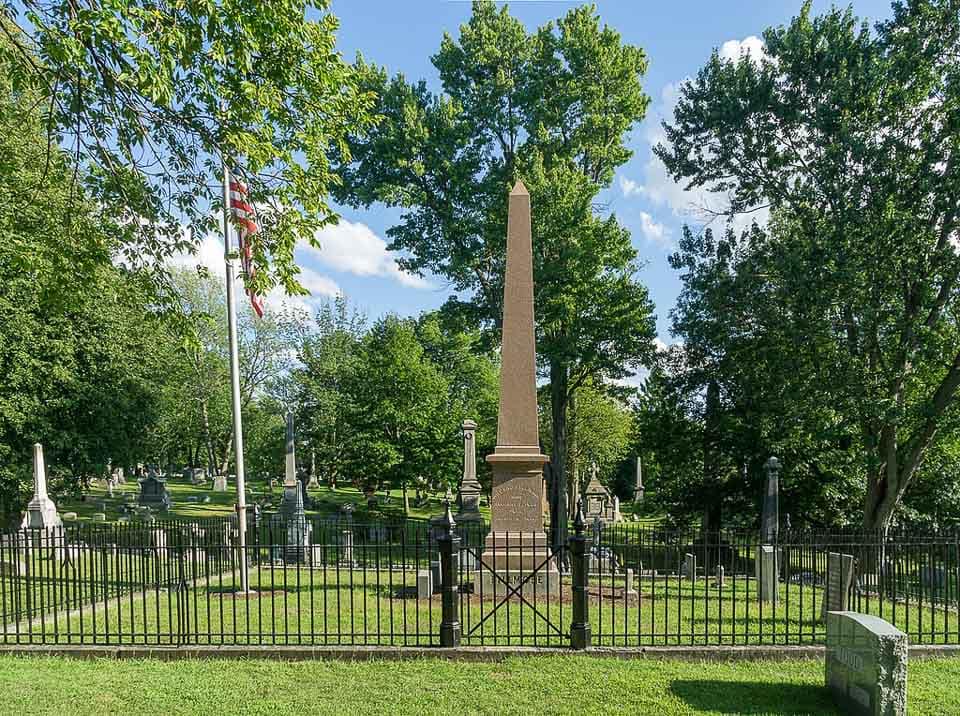
Fillmore passed away on March 8, 1874 after suffering a stroke. He was buried at Forest Lawn Cemetery in Buffalo. His gravesite is surrounded by a black metal fence and marked by a tall pink obelisk.
Franklin Pierce
Burial Place: Old North Cemetery in Concord, New Hampshire
Franklin Pierce served as the 14th President of the United States, holding office from 1853 to 1857.
Pierce’s presidency was marked by the intensifying sectional conflicts over slavery. His support for the Kansas-Nebraska Act of 1854, which allowed new territories to decide on the issue of slavery through popular sovereignty, further fueled tensions. Pierce’s presidency also saw the Gadsden Purchase in 1853, acquiring additional land from Mexico to facilitate the construction of a southern transcontinental railroad.
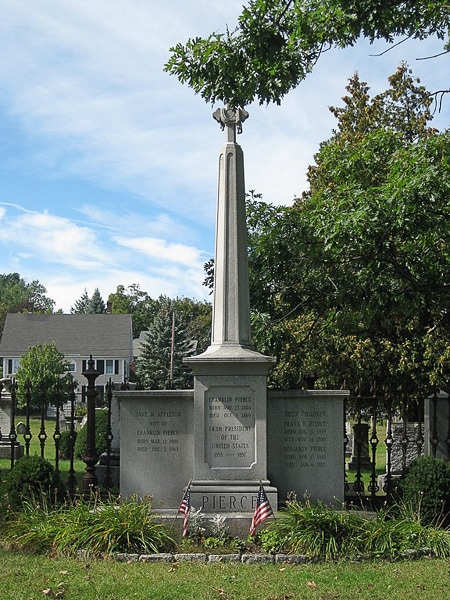
Pierce died on October 8, 1869, in Concord, New Hampshire at the age of 64. He was interred at the Old North Cemetery in the Minot enclosure next to his wife and two of his sons. A flowerbed and family monument topped with a cross marks the graves.
James Buchanan
Burial Place: Woodward Hill Cemetery in Lancaster, Pennsylvania
James Buchanan was the 15th President of the United States, serving from 1857 to 1861.
Buchanan had a long and distinguished career in public service, including serving in the Pennsylvania state legislature, the U.S. House of Representatives, and the Senate. During his presidency, Buchanan faced the controversial issue of slavery, particularly the question of whether slavery should be allowed in the territories. Buchanan struggled to find effective solutions to the growing crisis as the country moved closer to the Civil War.
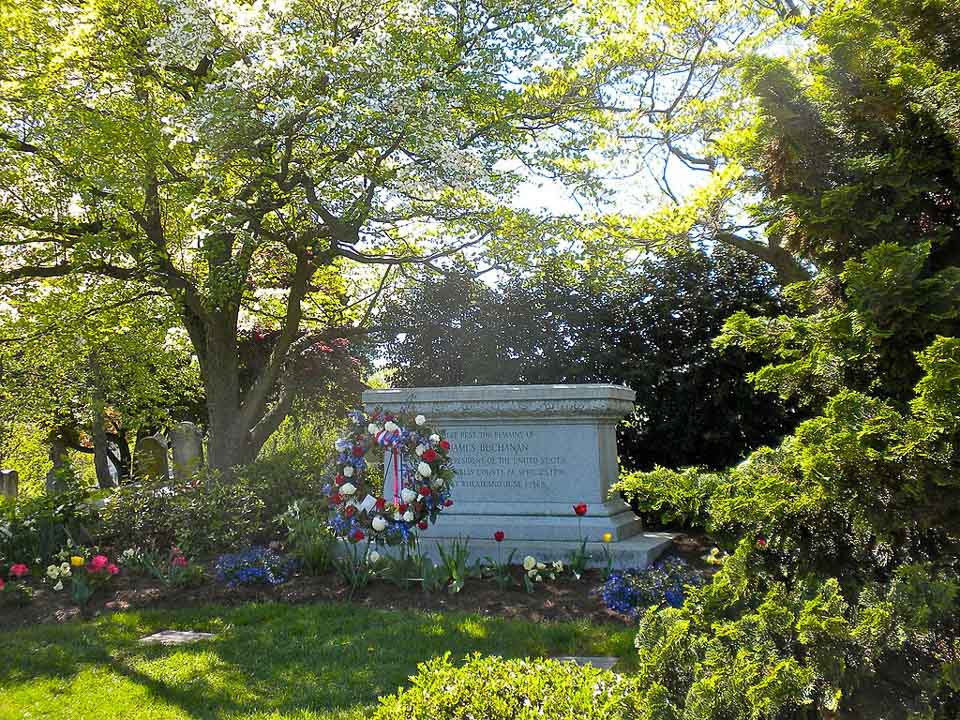
James Buchanan died on June 1, 1868, in Lancaster and was buried at Woodward Hill Cemetery. His gravesite is located on a small hillside with trees, shrubs, and flowers surrounding his stone tomb.
Abraham Lincoln
Burial Place: Oak Ridge Cemetery in Springfield, Illinois
Abraham Lincoln became the 16th President of the United States in 1861 and served until his assassination in 1865.
Lincoln is widely regarded as one of America’s greatest presidents and is best known for leading the country through the Civil War and for his role in ending slavery in 1863. His Gettysburg Address, a brief but powerful speech that articulated the principles of human equality and emphasized the importance of preserving the Union, is still regarded as one of the most influential speeches in American history.
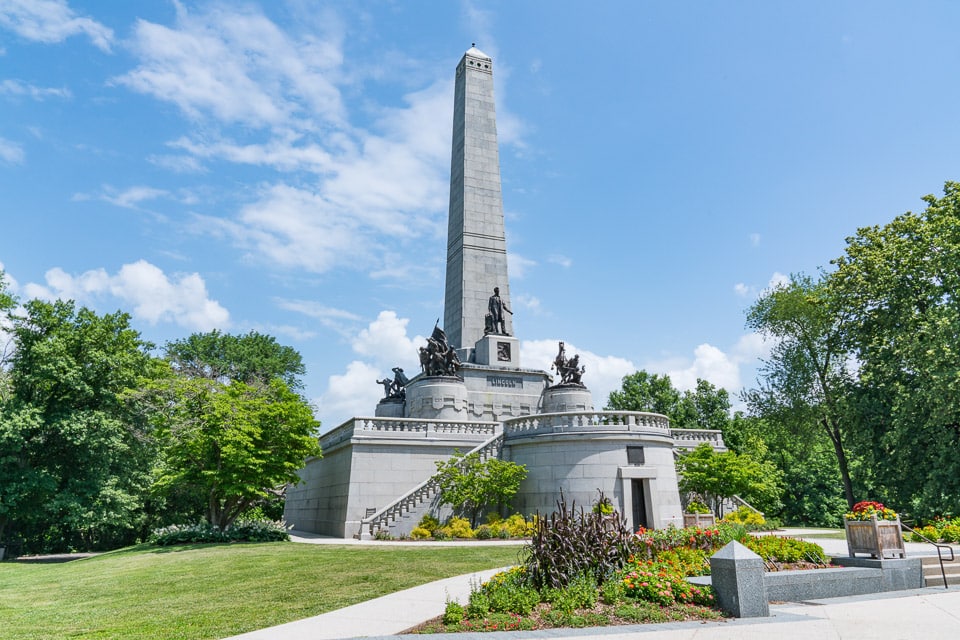
Lincoln died on April 15, 1865, the day after being shot by an assassin’s bullet. He was interred at Oak Ridge Cemetery in a temporary vault before being moved into a monumental tomb. The exterior of the Lincoln Tomb is made of granite and features a terrace, several bronze statues, and a towering obelisk. Visitors can go inside the tomb to see the marble block that marks the spot where Lincoln is buried.
Andrew Johnson
Burial Place: Andrew Johnson National Cemetery in Greeneville, Tennessee
Andrew Johnson, the 17th President of the United States, took office after the death of Abraham Lincoln serving from 1865 to 1869.
During his presidency, Johnson faced the formidable challenge of reconstructing after the Civil War. Tensions created by a series of proclamations implemented by Johnson during the Reconstriction era culminated in Johnson’s impeachment by the House of Representatives in 1868, making him the first president to be impeached.
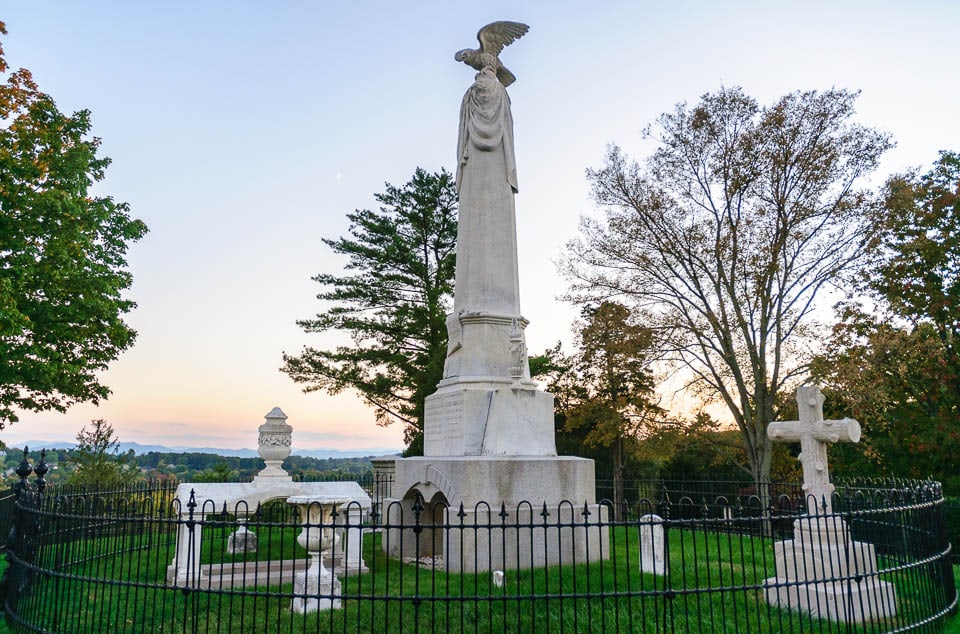
Johnson died of a stroke in 1875 at the age of 66. According to his wishes, Johnson was buried on a hill, on property he owned outside Greeneville, with a copy of the U.S. Constitution placed under his head and his body wrapped in an American flag. In 1906, the property was dedicated as the Andrew Johnson National Cemetery. Johnson’s 26 ft tall marble monument in the family plot depicts the Constitution and the Bible and is topped with a sculpture of an eagle.
Ulysses S. Grant
Burial Place: General Grant National Memorial in New York City
Ulysses S. Grant was the 18th President of the United States, serving from 1869 to 1877.
Grant is best known for his role as a prominent Union general during the American Civil War and for his efforts to promote civil rights and reconstruction during his presidency. He advocated for the protection of African American voting rights and the suppression of the Ku Klux Klan.
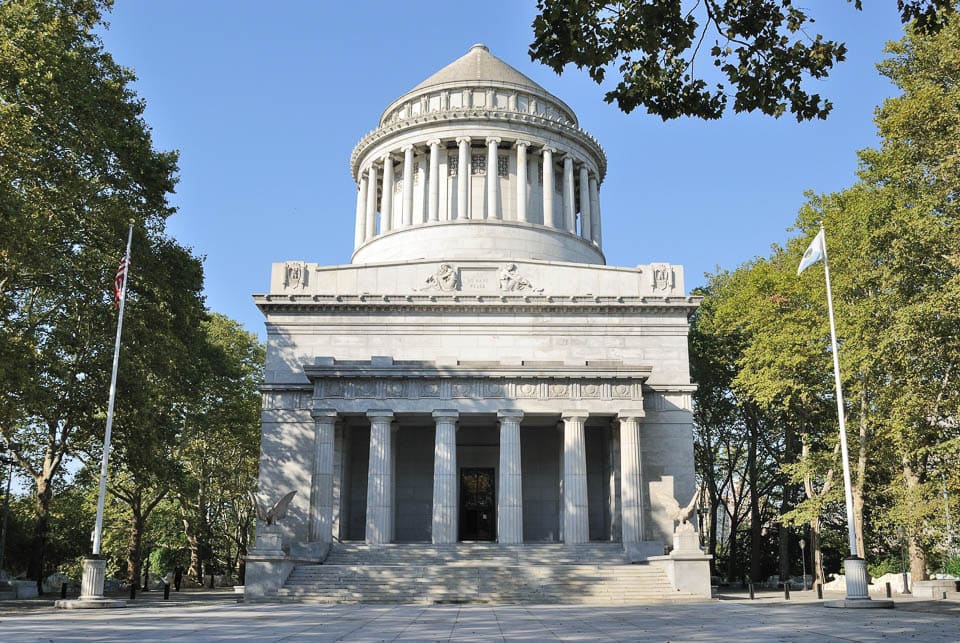
In 1885, Grant died of throat cancer at the age of 63. He was laid to rest in a temporary tomb in Riverside Park until a permanent tomb was built. Twelve years later, Grant’s Tomb was completed and his body was reinterred in an above-ground sarcophagus in the General Grant National Memorial. This Neoclassical domed building is the largest mausoleum in North America and was designated a U.S. National Memorial in 1958.
Rutherford B. Hayes
Burial Place: Hayes’ Spiegel Grove Estate in Fremont, Ohio
Rutherford Birchard Hayes became the 19th President of the United States in 1877 and served until 1881.
Hayes is best known for his contested and controversial election in 1876, which marked the end of the Reconstruction era in the South. As president, Hayes pursued civil service reform, advocating for merit-based appointments rather than political patronage. He faced challenges in dealing with economic issues, including the Great Railroad Strike of 1877.
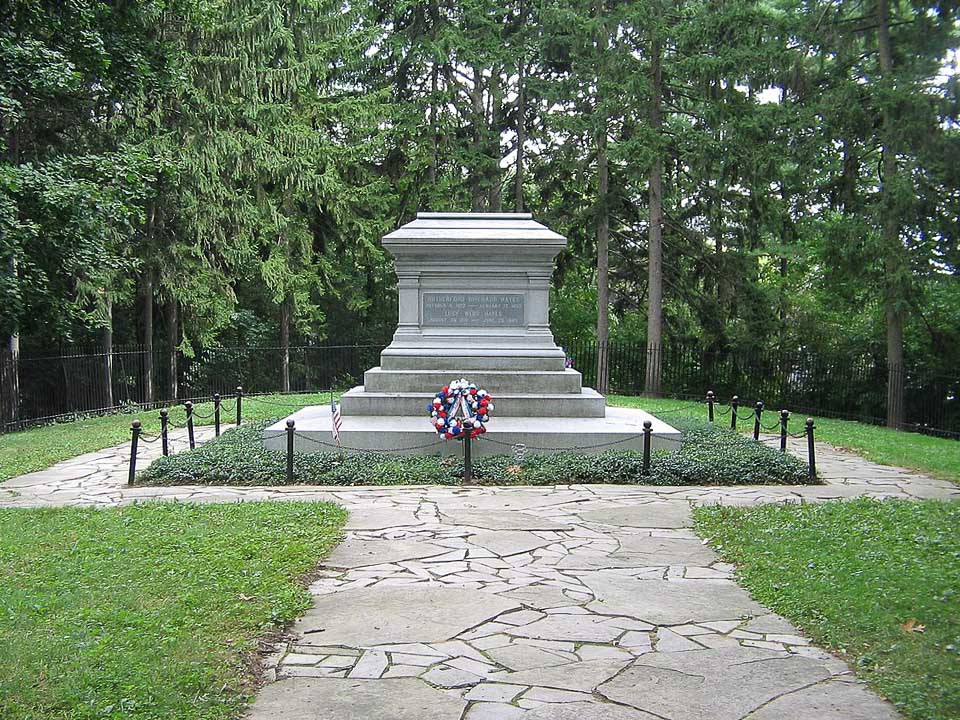
Hayes died on January 17, 1893, from complications of a heart attack. In 1915 his body was moved from Oakwood Cemetery to Spiegel Grove, his former estate, and interred in a large tomb with his wife. Their tomb stands prominently in a clearing surrounded by mature trees. More than a presidential burial site, the estate is also home to the Rutherford B. Hayes Presidential Center.
James A. Garfield
Burial Place: Lakeview Cemetery in Cleveland, Ohio
In 1881 James Abram Garfield became the 20th President of the United States. His presidency was cut short by an assassination, so he only served six months in office.
During his limited time in office, Garfield advocated for civil service reform and expanded educational opportunities.
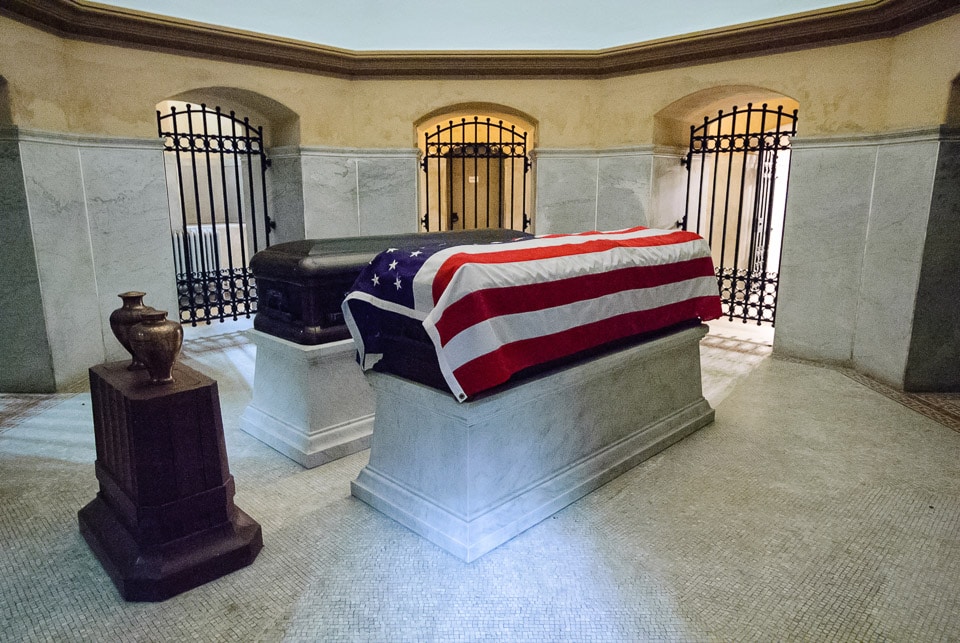
Garfield is buried at Lake View Cemetery in Cleveland, Ohio. His mausoleum, a majestic building known as the James A. Garfield Memorial, is a prominent feature of the cemetery. Inside the mausoleum there’s a marble statue of Garfield, granite columns, and decorative mosaics. His casket lies in a crypt on full display.
Chester A. Arthur
Burial Place: Albany Rural Cemetery in Menands, New York
After briefly serving as vice president under James A. Garfield, Chester A. Arthur became the 21st President of the United States. He held office from 1881 to 1885.
Arthur’s administration was marked by a commitment to civil service reform. Arthur supported and signed the Pendleton Civil Service Reform Act in 1883, which aimed to eliminate the spoils system by establishing a merit-based system for federal appointments. Another significant aspect of Arthur’s presidency was his dedication to modernizing the U.S. Navy. He authorized the construction of new warships, contributing to the expansion and improvement of the navy’s capabilities.
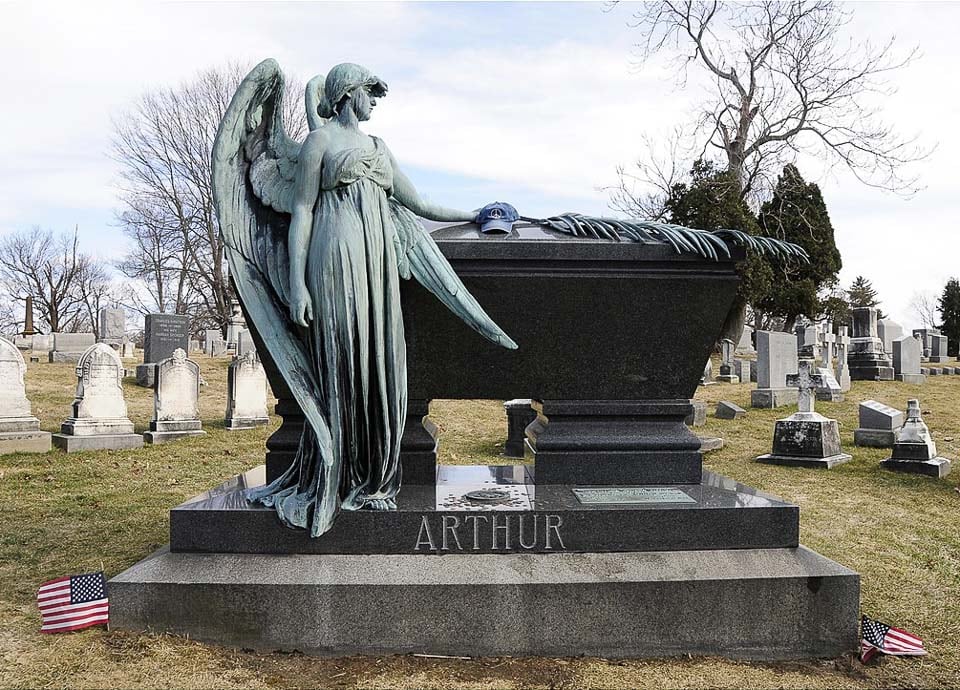
Arthur died on November 18, 1886, after suffering a cerebral hemorrhage. His gravesite in Albany Rural Cemetery features a bronze angel placing a palm leaf on his sarcophagus. Inlaid on the base of the sarcophagus is the seal of the President of the United States.
Grover Cleveland
Burial Place: Princeton Cemetery in New Jersey
Grover Cleveland was the 22nd and 24th President of the United States, serving non-consecutive terms from 1885 to 1889 and 1893 to 1897.
Cleveland’s first term in office was marked by a commitment to fiscal responsibility and efforts to reduce government corruption and inefficiency. During his second term, Cleveland faced economic challenges, including the Panic of 1893, and his administration struggled to address the resulting economic downturn.
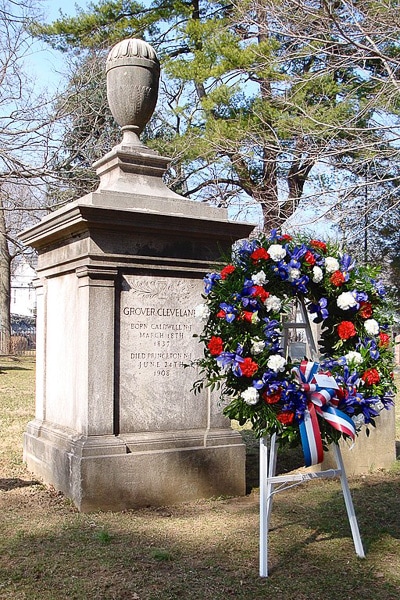
Cleveland passed away on June 24, 1908, of a heart attack. The monument at his burial place in Princeton Cemetery is surprisingly simple and understated for a two-term president- a stone pedestal topped with an urn.
Benjamin Harrison
Burial Place: Crown Hill Cemetery in Indianapolis, Indiana
Benjamin Harrison, grandson of President William Henry Harrison, was the 23rd President of the United States, serving from 1889 to 1893.
During his presidency, Harrison focused on issues such as civil rights, tariffs, and economic policies. He signed the Sherman Antitrust Act into law, addressing concerns about monopolies and corporate power. Harrison also presided over the admittance of six western states into the Union and the creation of the national forest reserves.
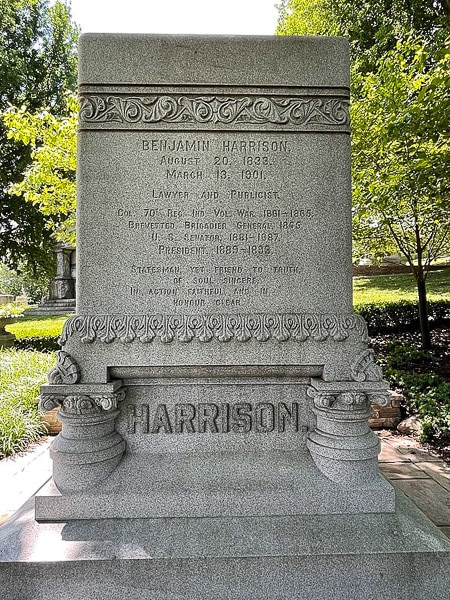
Harrison died at home on March 13, 1901, of pneumonia and was buried in Crown Hill Cemetery. His grave is marked by a prominent monument sculpted with decoration and surrounded by shrubs.
William McKinley
Burial Place: McKinley National Memorial in Canton, Ohio
William McKinley became the 25th President of the United States in 1897 and served until his assassination in 1901.
McKinley’s presidency is often associated with the nation’s transition into a period of economic prosperity, imperial expansion, and the Spanish-American War. He signed the Gold Standard Act in 1900, which established gold as the only standard for redeeming paper money, stabilizing the economy.
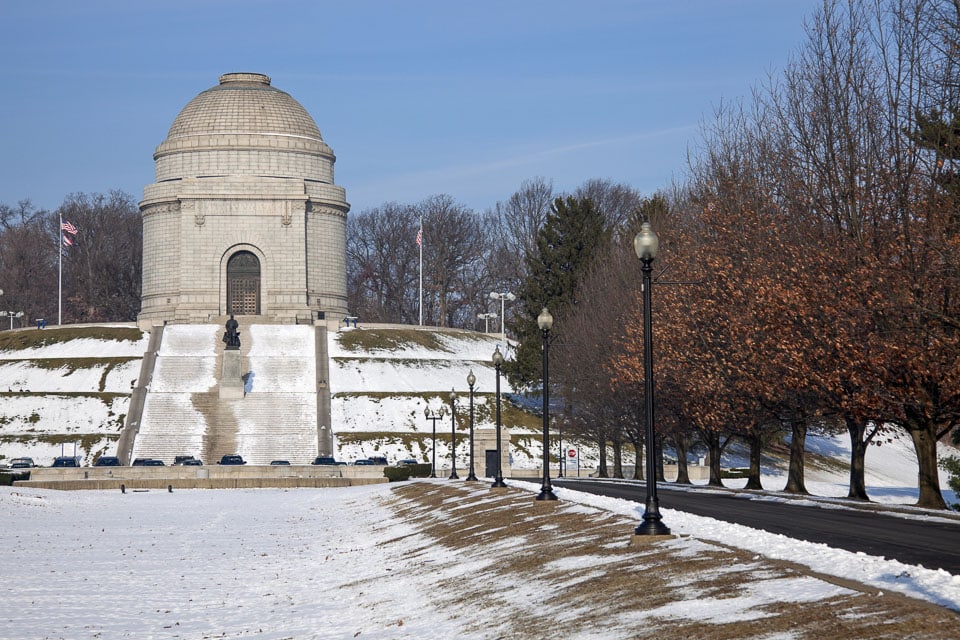
William McKinley is buried in the McKinley National Memorial in Canton, Ohio. The large domed mausoleum houses the remains of McKinley, his wife Ida, and their two daughters. The memorial site, dedicated in 1907, is also home to a museum and a library, serving as a tribute to McKinley’s life and presidency.
Theodore Roosevelt
Burial Place: Youngs Memorial Cemetery in Oyster Bay, New York
Theodore Roosevelt was the 26th President of the United States, serving from 1901 to 1909.
Roosevelt’s presidency is remembered for its vigorous domestic and foreign policies, his commitment to conservation, and the expansion of the United States’ role on the world stage. Some of his greatest achievements include facilitating the construction of the Panama Canal, signing the Antiquities Act which created national monuments, and protecting forest and wildlife lands through the establishment of numerous national parks and national forests.
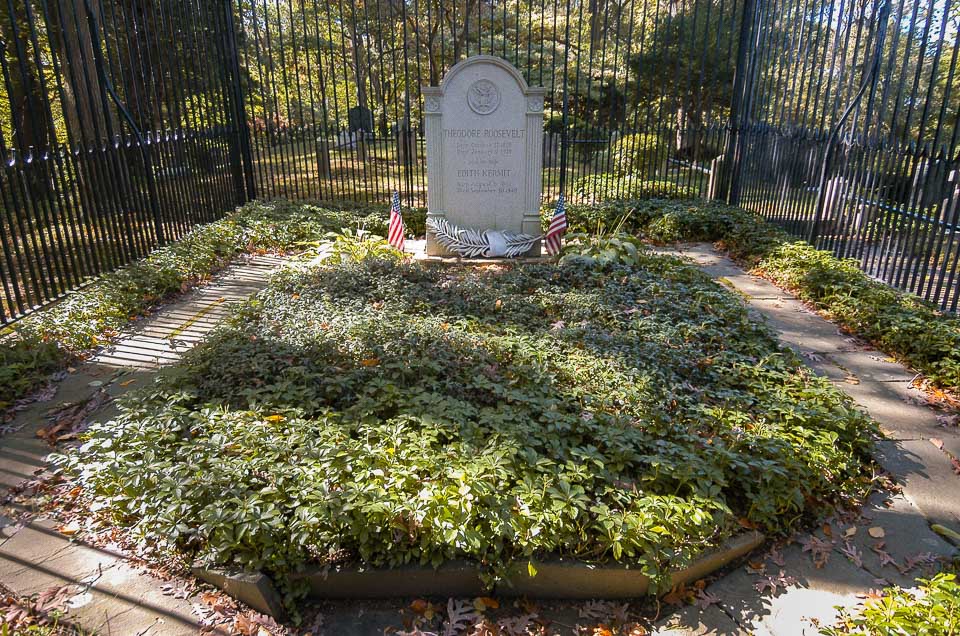
Theodore Roosevelt passed away on January 6, 1919, after suffering a pulmonary embolism. He is buried at Youngs Memorial Cemetery in Oyster Bay, near his family estate at Sagamore Hill. Roosevelt’s headstone has a carving of the seal of the President of the United States, but is otherwise fairly modest.
William Howard Taft
Burial Place: Arlington National Cemetery, Virginia
William Howard Taft was the 27th President of the United States, holding office from 1909 to 1913. Taft is notable for being the only person to have served as both President of the United States and chief justice of the United States.
Taft’s presidency focused on implementing a progressive agenda, including trust-busting and tariff reform. Taft also advocated for the establishment of the postal savings system and signed into law the Mann-Elkins Act, expanding the regulatory authority of the Interstate Commerce Commission.
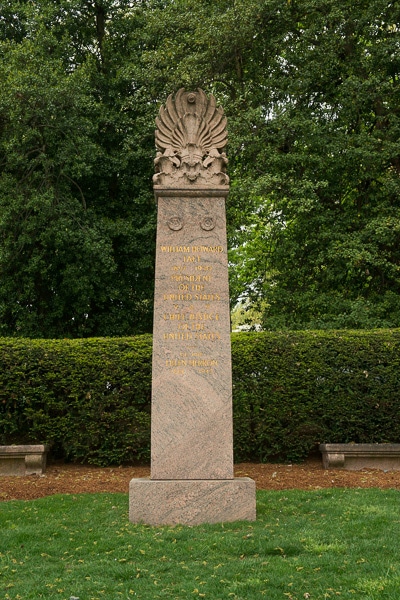
William Howard Taft passed away on March 8, 1930, in Washington, D.C. He is buried in Arlington National Cemetery, a prominent military cemetery located across the Potomac River from Washington, D.C. Taft’s grave is marked by a 14 ft tall mahogany granite headstone that features a carved apex and inscriptions in gold leaf.
Woodrow Wilson
Burial Place: Washington National Cathedral in Washington D.C.
Thomas Woodrow Wilson was the 28th President of the United States, serving from 1913 to 1921.
Wilson’s presidency was marked by his domestic agenda including signing the Federal Reserve Act which reformed the banking system, the Clayton Antitrust Act which sought to strengthen antitrust laws, and the 19th Amendment granting women the right to vote. He is also known for his leadership during World War I and for playing a crucial role in creating the League of Nations, a precursor to the United Nations.
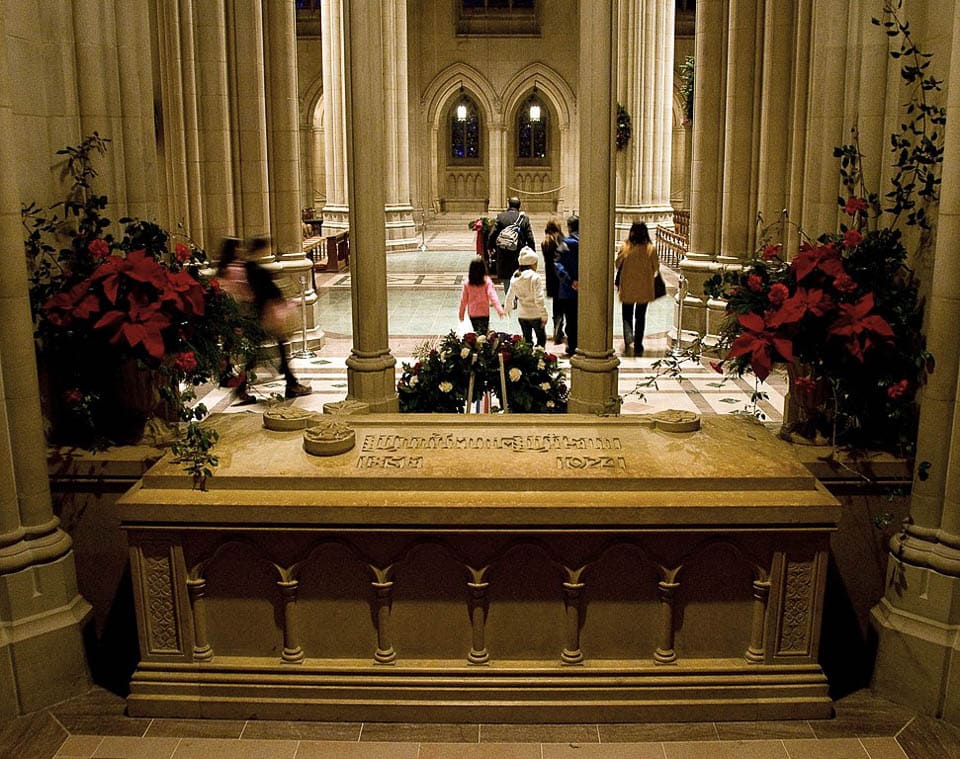
Woodrow Wilson passed away on February 3, 1924, at the age of 67. He was interred in Washington National Cathedral in a sarcophagus adorned with a cross-shaped crusader’s sword with a rounded tip to symbolize peace.
Warren G. Harding
Burial Place: The Harding Memorial in Marion, Ohio
Warren Gamaliel Harding was the 29th President of the United States, serving from 1921 until his death in 1923.
Harding’s presidency was marked by a desire for economic recovery after World War I. However, it was marred by the Teapot Dome scandal, in which his administration was implicated in corrupt dealings involving oil reserves. Despite the controversies, Harding did make some notable achievements, such as the Washington Naval Conference of 1921–1922, which aimed to limit naval armaments and promote international peace.
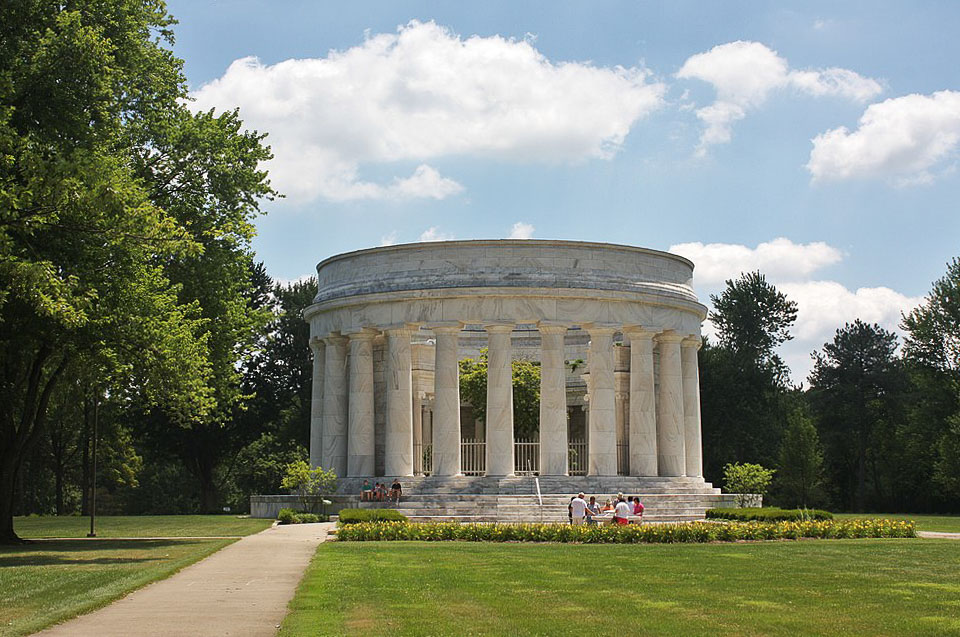
Harding died unexpectedly on August 2, 1923, in San Francisco while on a western tour. He was buried in Marion, Ohio, at the Harding Memorial (also known as the Harding Tomb) when it was completed in 1927. The circular marble structure resembles a Greek temple and the tomb of Harding and his wife are in the middle.
Calvin Coolidge
Burial Place: Plymouth Notch Cemetery, Vermont
John Calvin Coolidge Jr. became the 30th President of the United States in 1923 following the death of Warren G. Harding. He won a subsequent term in the 1924 election and served until 1929.
Coolidge was known for his fiscal conservatism, belief in limited government, and pro-business stance. His presidency was marked by rapid economic growth and he was often associated with the phrase “The business of America is business.”
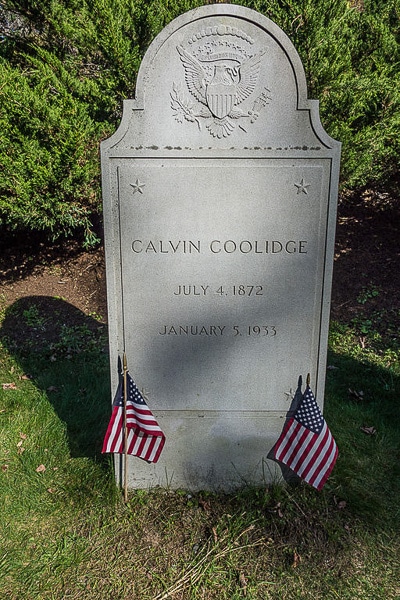
Calvin Coolidge passed away on January 5, 1933, from coronary thrombosis. He is buried in the Notch Cemetery in Plymouth, Vermont, alongside his wife, Grace. His modest burial site features a tombstone with the eagle and coat of arms from the presidential seal.
Herbert Hoover
Burial Place: Hoover Presidential Library in West Branch, Iowa
Herbert Hoover was the 31st President of the United States, serving from 1929 to 1933.
Just months into Hoover’s presidency, the stock market crashed signaling the beginning of the Great Depression. His administration struggled to respond effectively to the economic crisis, facing widespread unemployment, bank failures, and a collapse of industrial production.
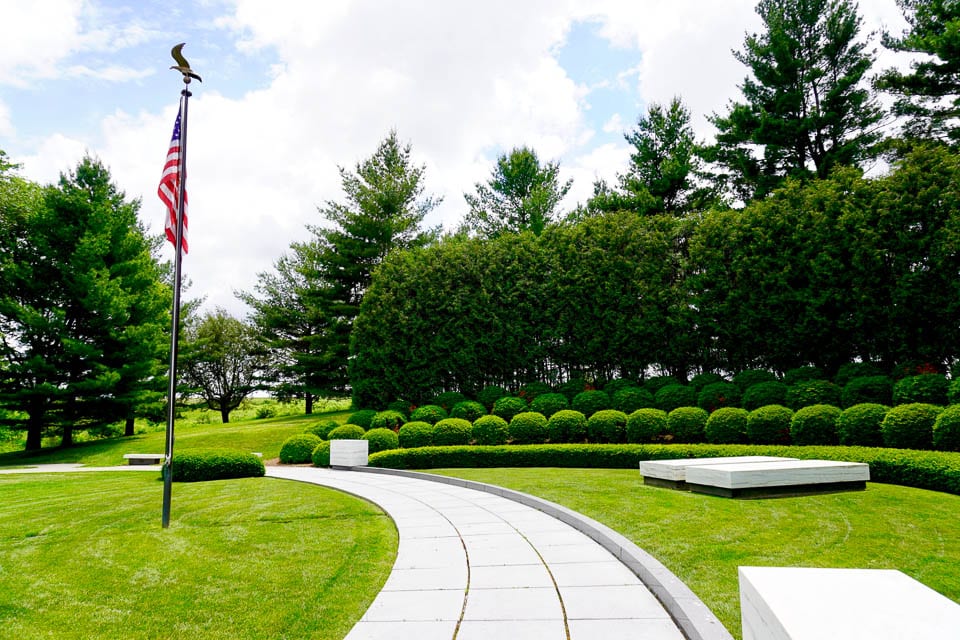
Hoover died at the age of 90 on October 20, 1964. He is buried alongside his wife near the Herbert Hoover Presidential Library and Museum in West Branch, Iowa. A slab of stone marks his gravesite which is backed by manicured shrubs and looks out onto an American flag.
Franklin D. Roosevelt
Burial Place: Roosevelt’s Springwood Estate in Hyde Park, New York
Franklin Delano Roosevelt was the 32nd President of the United States, serving an unprecedented four terms from 1933 to 1945.
Roosevelt led the nation through the Great Depression and most of World War II, implementing the New Deal programs and reshaping the role of the federal government in American society.
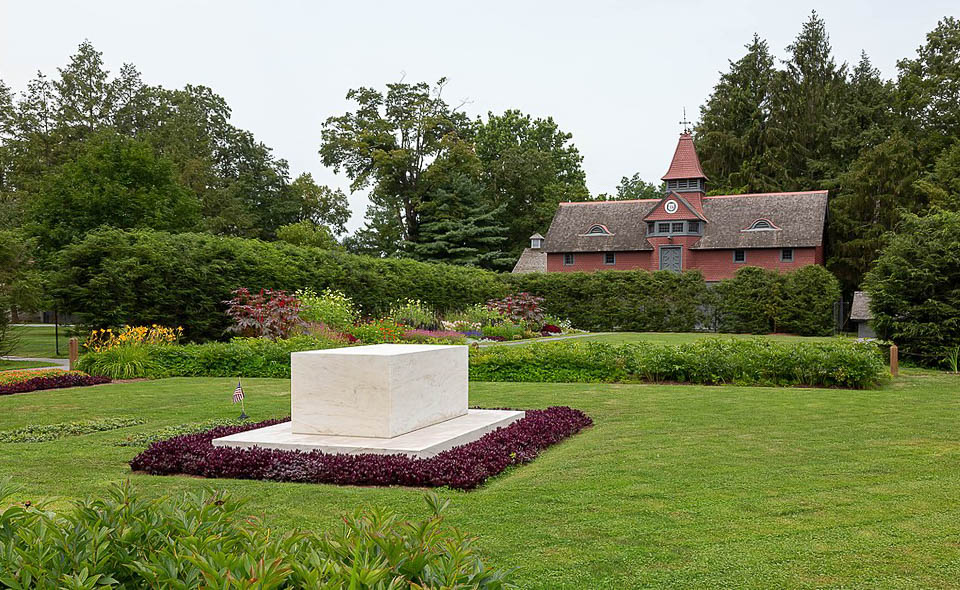
On April 12, 1945 Roosevelt died of a cerebral hemorrhage in Warm Springs, Georgia. He was buried in the rose garden at the Springwood estate, his lifelong home. His gravesite is shared with his wife and is marked by a rectangular block of white marble engraved with their names and birth and death dates. The estate is preserved as the Home of Franklin D. Roosevelt National Historic Site.
Harry S. Truman
Burial Place: Harry S. Truman Presidential Library and Museum in Independence, Missouri
Harry S. Truman was the 33rd President of the United States, serving from 1945 to 1953.
Truman assumed the presidency during the final months of World War II and faced significant challenges, including the decision to use atomic bombs on Hiroshima and Nagasaki. His presidency also encompassed the early years of the Cold War.
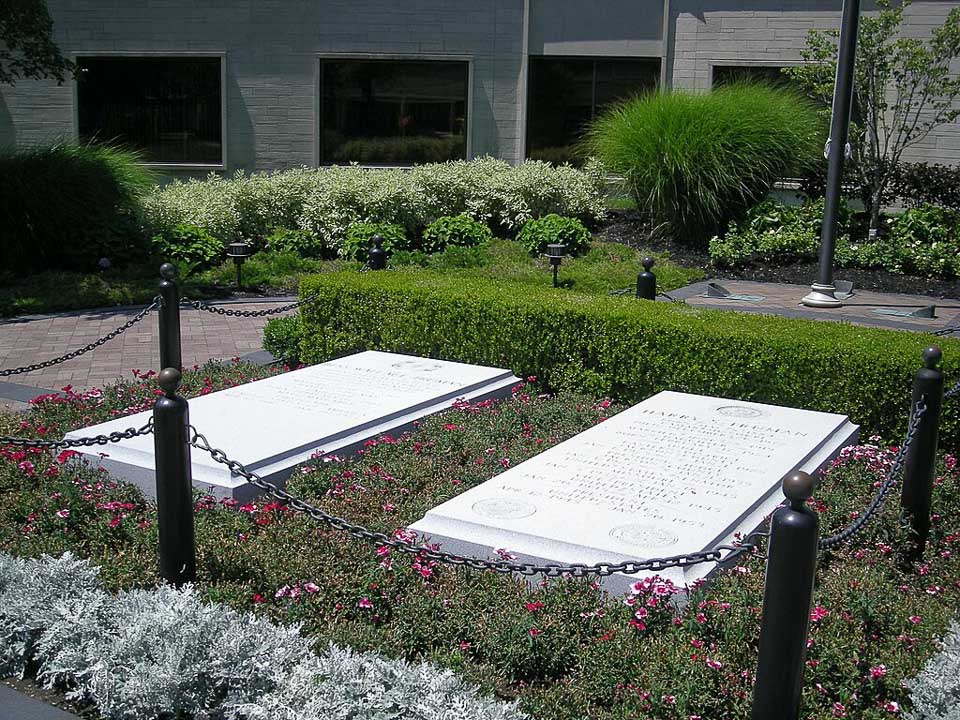
Truman died on December 26, 1972, at the age of 88. He is buried at the Harry S. Truman Presidential Library and Museum alongside his wife, Bess. The gravesite is located in the courtyard of the library and Truman’s tombstone is engraved with a list of his notable life events, both personal and professional.
Dwight D. Eisenhower
Burial Place: Dwight D. Eisenhower Presidential Library and Museum in Abilene, Kansas
Dwight David Eisenhower served two terms as the 34th President of the United States from 1953 to 1961.
As president, Eisenhower focused on domestic and foreign policy, including authorizing construction of the Interstate Highway System and implementing the “Eisenhower Doctrine” to contain the spread of communism in the Middle East. He also signed the Civil Rights Act of 1957, which was the first federal civil rights legislation since Reconstruction. After his re-election, he continued to address Cold War tensions, famously warning about the “military-industrial complex” in his farewell address.
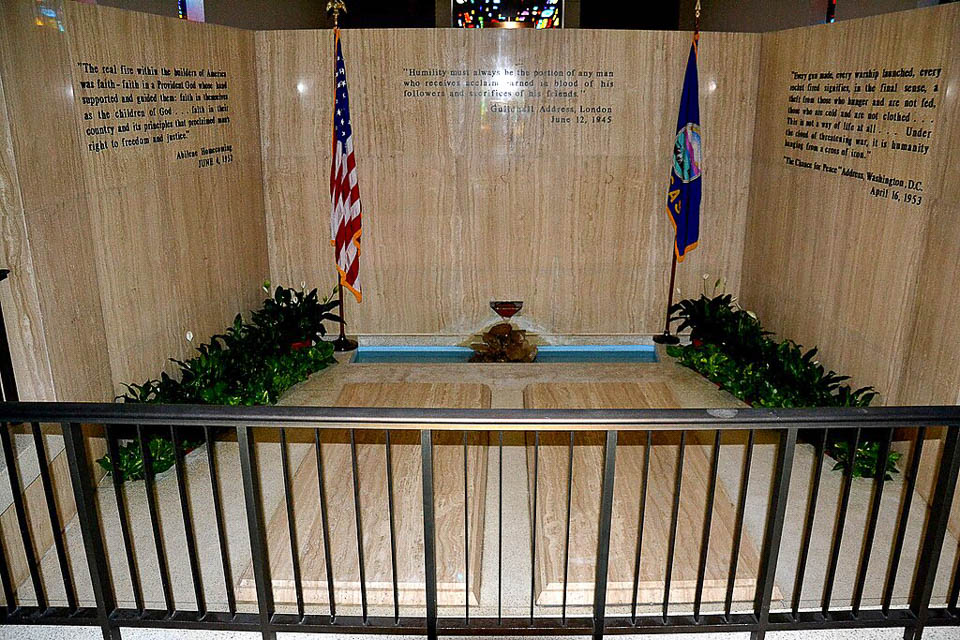
Eisenhower passed away on March 28, 1969, at the age of 78. He was buried in the chapel at the Eisenhower Presidential Library, Museum, and Boyhood Home. As requested, was laid to rest in his World War II uniform. His gravesite is surrounded by a wall with quotes from some of his speeches.
John F. Kennedy
Burial Place: Arlington National Cemetery, Virginia
John Fitzgerald Kennedy, was the 35th President of the United States, serving from 1961 until his assassination in 1963.
Kennedy, often referred to as JFK, was the youngest person ever elected to the presidency and is remembered for his charisma, leadership during the Cold War, and the inspiration he brought to the nation. As president, Kennedy faced critical challenges, including the Bay of Pigs Invasion in Cuba and the Cuban Missile Crisis, which brought the United States and the Soviet Union to the brink of nuclear war. Kennedy also initiated the Alliance for Progress in Latin America and supported the Civil Rights Movement.
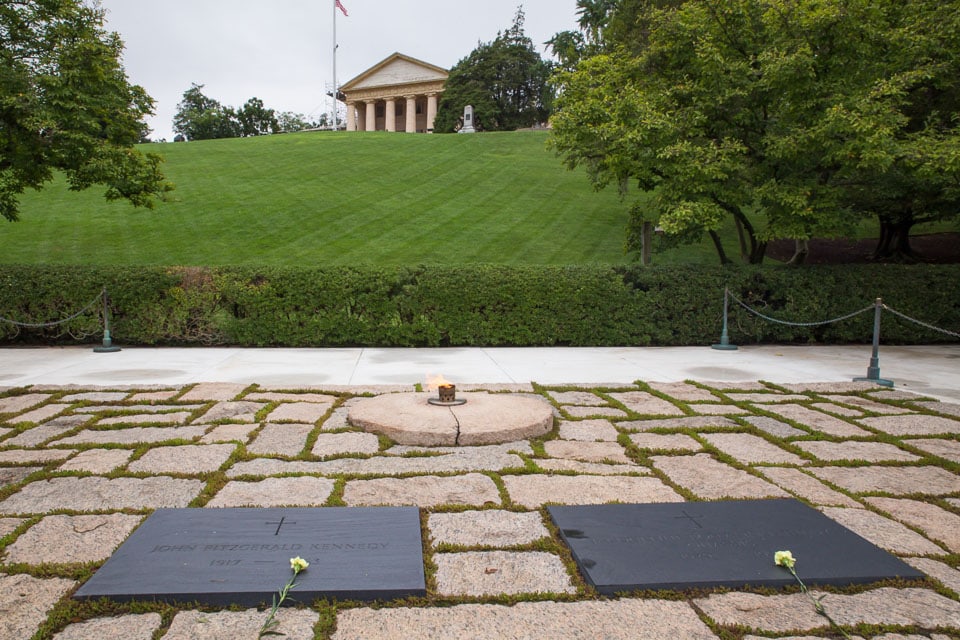
John F. Kennedy is one of the most famous burials at Arlington National Cemetery. A simple black slate tablet set flat in the ground marks JFK’s grave on a terrace facing Washington D.C. An eternal flame and fieldstones from Cape Cod complete the gravesite.
Lyndon B. Johnson
Burial Place: Lyndon B. Johnson National Historical Park in Stonewall, Texas
Lyndon Baines Johnson assumed the presidency after the assassination of John F. Kennedy becoming the 36th President of the United States. He served from 1963 to 1969.
Johnson sought to carry forward Kennedy’s legacy and launched a series of ambitious social programs known as the “Great Society,” which aimed to eliminate poverty and racial injustice. One of Johnson’s most significant achievements was the passage of the Civil Rights Act of 1964, which aimed to end segregation and discrimination based on race, colour, religion, sex, or national origin. He also signed the Voting Rights Act of 1965, which prohibits racial discrimination in voting. However, Johnson’s presidency became increasingly defined by escalating U.S. involvement in the Vietnam War, leading to domestic protests and social unrest.
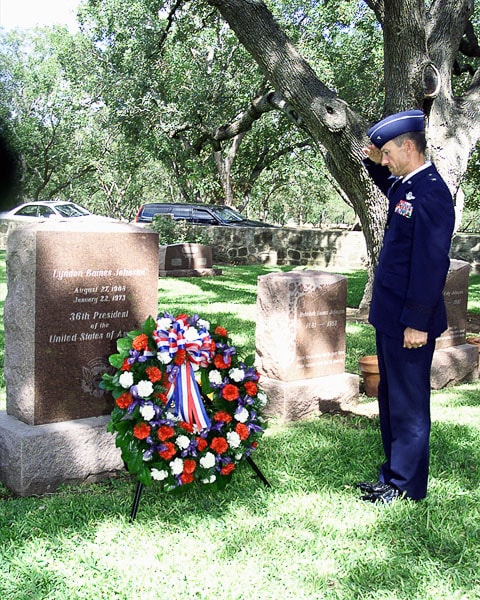
Lyndon B. Johnson died on January 22, 1973, at his ranch in Stonewall, Texas. He is buried in his family’s private cemetery at the Lydon B. Johnson National Historical Park, site of Johnson’s birthplace and home. The cemetery is shaded by trees and surrounded by a low, stone wall. Johnson’s headstone features the eagle and coat of arms from the presidential seal.
Richard Nixon
Burial Place: Richard Nixon Presidential Library and Museum in Yorba Linda, California
Richard Nixon was the 37th President of the United States, serving from 1969 to 1974.
Nixon’s presidency was marked by significant achievements in foreign policy, including the normalization of relations with China and the gradual withdrawal of U.S. troops from the Vietnam War. Domestically, he implemented environmental protection measures and the creation of the Environmental Protection Agency (EPA). His achievements were ultimately overshadowed by the Watergate scandal that led to his resignation.
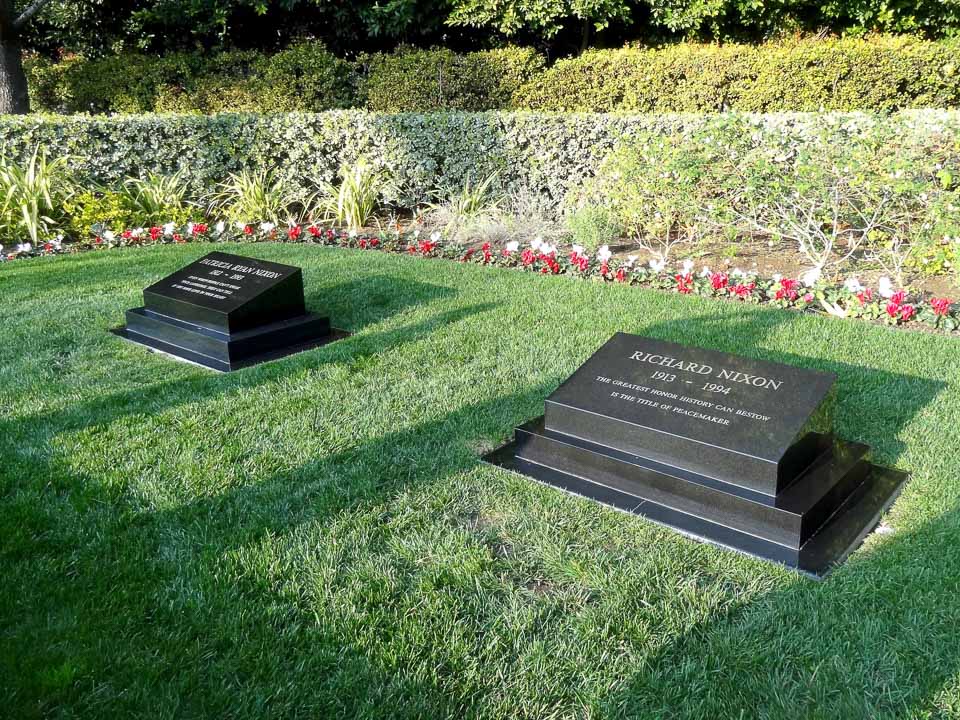
Nixon passed away on April 22, 1994, at the age of 81. He is buried on the grounds of the Richard Nixon Presidential Library and Museum situated near the house where he was born. Nixon’s gravesite is marked by a simple black tombstone engraved with the words “The greatest honor history can bestow is the title of peacemaker.”
Gerald Ford
Burial Place: Gerald R. Ford Presidential Museum in Grand Rapids, Michigan
Gerald Rudolph Ford Jr. was the 38th President of the United States, serving from 1974 to 1977 following the resignation of Richard Nixon.
Ford faced the challenge of healing a nation divided by the Watergate scandal and the Vietnam War. He made the controversial decision to pardon Richard Nixon for any crimes he may have committed while in office. Ford’s presidency also dealt with the worst recession since the Great Depression.
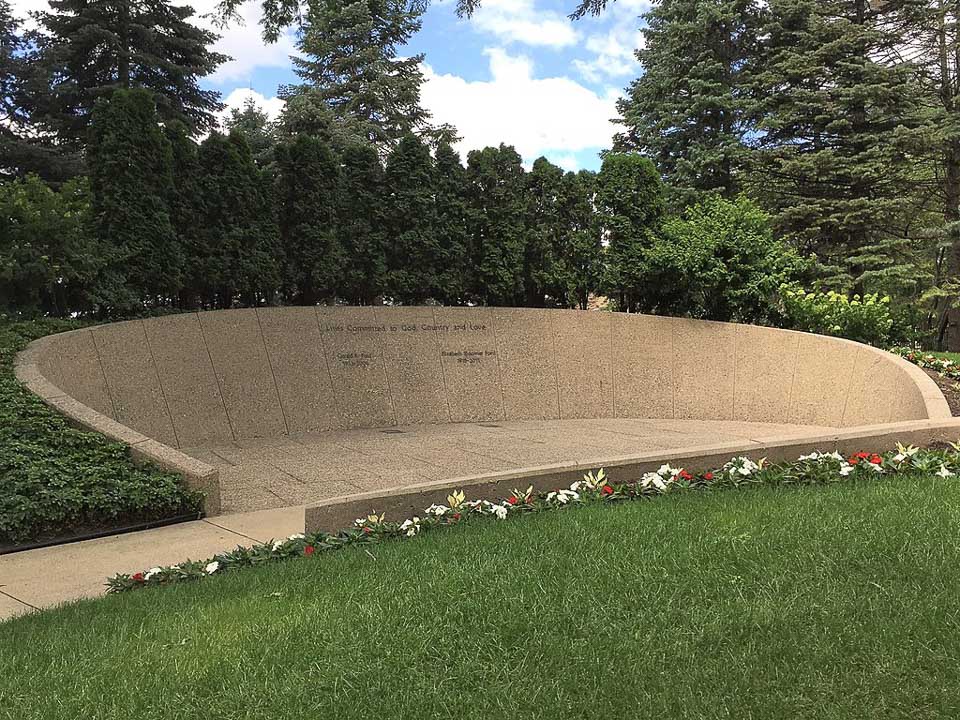
Ford passed away on December 26, 2006, at the age of 93. He was buried on the grounds of the Gerald R. Ford Presidential Museum in Grand Rapids, Michigan. His burial site is marked with a curved stone wall.
Ronald Reagan
Burial Place: Ronald Reagan Presidential Library and Museum in Simi Valley, California
Ronald Reagan was the 40th President of the United States, serving two terms from 1981 to 1989.
Reagan pursued a conservative agenda, emphasizing the free-market and tax cuts, economic policies that later became known as “Reaganomics”. His strong stance against the Soviet Union and defense buildup escalated the Cold War, but ultimately his hard-line rhetoric contributed to the eventual end of the Cold War and Soviet communism.
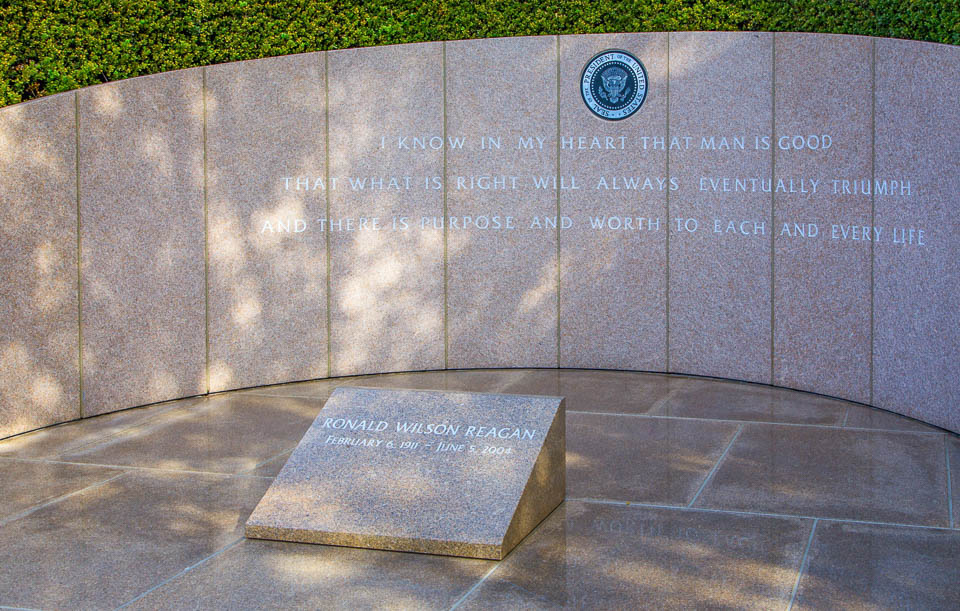
Reagan died on June 5, 2004, at the age of 93. He is buried outside of the Ronald Reagan Presidential Library alongside his wife Nancy, who passed away in 2016. His gravesite is encircled by a curved fence and wall engraved with the words “I know in my heart that man is good, that what is right will always eventually triumph, and there is purpose and worth to each and every life.”
George H.W. Bush
Burial Place: George H.W. Bush Presidential Library and Museum in College Station, Texas
George Herbert Walker Bush was the 41st President of the United States, serving from 1989 to 1993.
As president, Bush faced significant foreign policy challenges, including the collapse of the Soviet Union and the reunification of Germany. He oversaw the U.S. response to the invasion of Kuwait by Iraq in 1990, leading to the Gulf War. Domestically, his presidency was marked by efforts to address budget deficits and environmental concerns.
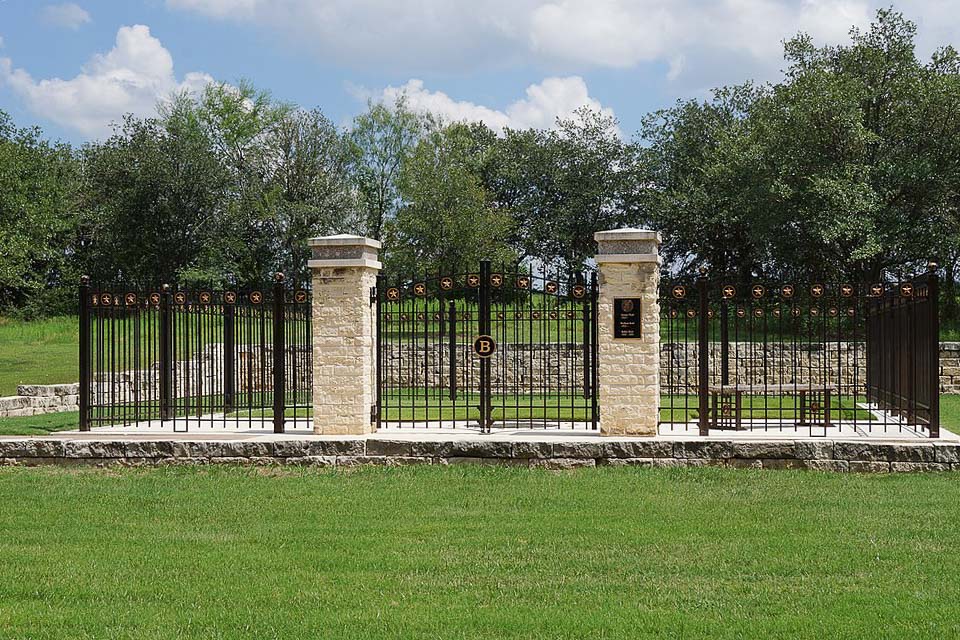
George H.W. Bush passed away on November 30, 2018, at the age of 94. He is buried alongside his wife Barbara and daughter Pauline at the George H.W. Bush Presidential Library and Museum on the campus of Texas A&M University. The burial plot is surrounded by a decorative fence and Bush’s gravesite is marked by a simple white cross and memorial stone. A large seal of the President of the United States is embedded in the walkway in front of the graves.
Final Thoughts About Visiting the Presidents’ Burial Sites
The presidential burial sites hold historical, cultural, and personal significance, making them engaging destinations for those interested in the nation’s past and its leaders.
While visiting the graves of U.S. presidents, you can reflect on the events and decisions that occurred during their time in office, express your patriotism and civic pride, and of course, pay respects to the leaders who had a profound impact on the country’s development.
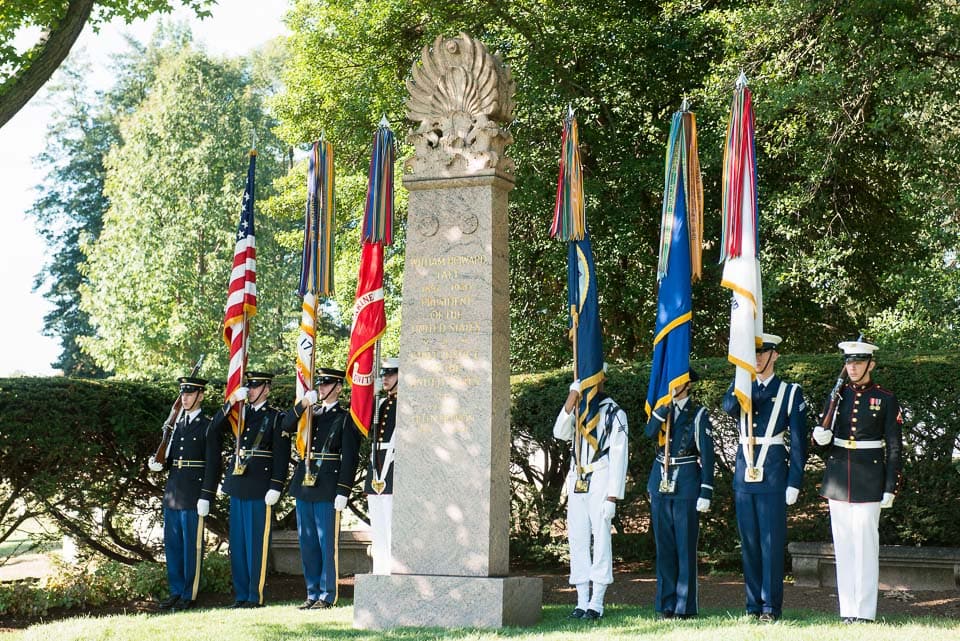
More Burial Places in the United States
- Cemeteries in Boston- Historic Boston Cemeteries to Visit
- Granary Burying Ground- Burial Place of Three Founding Fathers of the U.S.A.
- Tomb of the Unknown Soldier- A Guide to Arlington National Cemetery’s Tomb of the Unknown Soldier
- Mount Auburn Cemetery- The First Rural Cemetery in the United States
